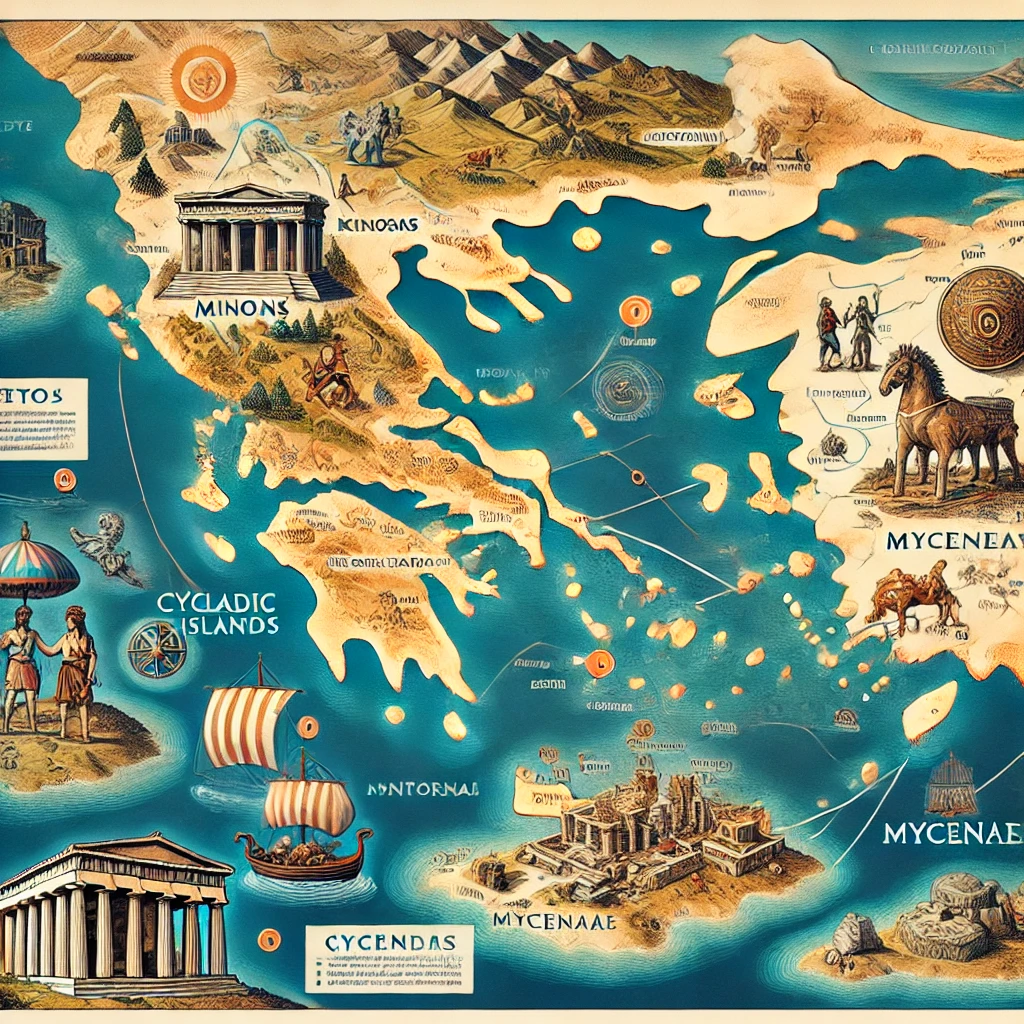The Aegean Bronze Age civilizations thrived in a complex web of islands and mainland regions, setting the stage for the rich tapestry of ancient Greek culture. Key geographic regions included Crete, famous for the Minoan civilization, and mainland Greece, home to the Mycenaean power centers. These civilizations left behind a legacy of advanced architecture, sophisticated art, and complex societal structures. Transitioning across the Aegean Sea, they established pivotal cities, each contributing uniquely to the cultural and historical fabric of the era. Understanding their geographical context is essential for appreciating their contributions to history.
Key Geographic Regions of the Aegean Bronze Age
The Aegean Bronze Age civilizations thrived in specific key regions, each contributing to a rich tapestry of cultural and economic development. Below are the primary geographic areas where these influential societies emerged:
- Crete: Known for the Minoan civilization, Crete was a major hub of trade and culture. The island’s strategic location facilitated extensive maritime commerce across the Aegean Sea.
- Mainland Greece: This area saw the rise of the Mycenaean civilization, characterized by powerful city-states like Mycenae, Tiryns, and Pylos. These centers of power played a pivotal role in shaping the region’s political landscape.
- Cycladic Islands: These islands, scattered in the central Aegean Sea, were instrumental in connecting the mainland and Crete. Renowned for their distinctive marble figurines and seafaring prowess, the Cycladic Islands remained crucial nodes in the cultural exchange networks.
- Anatolia (Western Turkey): Although primarily associated with the rise of the Hittite Empire, western Anatolia interacted extensively with Aegean Bronze Age civilizations, especially through trade and cultural exchanges.
Understanding these foundational regions gives us vital insights into the complexity and interconnectedness of Aegean Bronze Age civilizations. Each area contributed unique elements that, when woven together, portray a dynamic and influential era.
Major Cities and Sites of the Minoan Civilization
The Minoan civilization, one of the prominent Aegean Bronze Age civilizations, flourished on the island of Crete. Several key cities and archaeological sites illustrate the grandeur and complexity of this ancient society.
Knossos stood as the most significant city, often considered the political and cultural heart of the Minoans. The Palace of Knossos features intricate frescoes, elaborate architecture, and advanced infrastructure, demonstrating the civilization’s sophistication.
Other important sites include:
- Phaistos: Known for its palatial complex and the enigmatic Phaistos Disc, an archaeological find that continues to intrigue scholars.
- Malia: Famous for its large palace and potential role as a religious and economic center.
- Zakros: Positioned in eastern Crete, featuring a palace with unique artifacts and a direct connection to trade networks.
Moreover, the Minoans developed coastal towns like Amnisos and Kommos, both serving as vital ports for trade and marine activities.
In summary, the major cities and sites of the Minoan civilization give us invaluable insights into one of the most fascinating Aegean Bronze Age civilizations, highlighting their urban planning, art, and trade networks.
Centers of Power in Mycenaean Greece
During the Aegean Bronze Age, Mycenaean Greece stood out with several prominent centers of power. These sites were not only crucial for their political and military might but also for their contributions to culture and architecture.
Key Centers of Mycenaean Power:
- Mycenae: The most famous of the Mycenaean cities, known for its Lion Gate and imposing citadel.
- Tiryns: Renowned for its massive, well-preserved cyclopean walls.
- Pylos: The palace of Nestor, notable for its Linear B tablets, which provide insight into Mycenaean administration.
- Thebes: Another influential city, linked to numerous myths and archaeological discoveries.
- Athens: Though more famed for its classical era, Athens had significant importance during the Mycenaean period too.
Comparison of Key Centers:
| City | Noteworthy Features | Significance |
|---|---|---|
| Mycenae | Lion Gate, Treasury of Atreus | Political and military hub, rich archaeological finds |
| Tiryns | Cyclopean walls | Military strength, architectural marvel |
| Pylos | Palace of Nestor, Linear B tablets | Administrative insight, historical records |
| Thebes | Myths, extensive archaeological sites | Cultural importance, storied history |
| Athens | Early Mycenaean structures | Continuous habitation, early political influence |
These centers illustrate the complexity and spread of Aegean Bronze Age civilizations, with each city contributing uniquely to the era’s legacy. By examining these power hubs, we gain invaluable insights into the Aegean Bronze Age civilizations and their enduring impact on history.
Frequently Asked Questions
Where was the Minoan civilization located?
The Minoan civilization was primarily located on the island of Crete, which lies in the southern part of the Aegean Sea. The civilization is renowned for its advanced social structure, impressive architectural accomplishments such as the palace at Knossos, and significant contributions to art and religion in the Bronze Age.
What are the geographical boundaries of Mycenaean Greece?
The Mycenaean civilization was based on the mainland of Greece, particularly in the Peloponnese region. Prominent Mycenaean centers included Mycenae itself, Tiryns, Pylos, and Thebes. This civilization also exerted influence over islands in the Aegean Sea and the western coast of Asia Minor (modern-day Turkey).
Did the Cycladic civilization occupy only the Cyclades islands?
Yes, the Cycladic civilization was primarily spread across the Cyclades islands in the Aegean Sea, with notable islands including Naxos, Paros, and Santorini (also known as Thera). These islands collectively formed a network that played a crucial role in maritime trade and cultural exchange during the Bronze Age.
How did the geographical location impact Aegean Bronze Age civilizations?
The geography of the Aegean region, with its numerous islands and indented coastlines, facilitated extensive maritime trade and cultural interaction among the civilizations. The proximity to other ancient cultures such as the Egyptians, Hittites, and Mesopotamians also influenced the development of Aegean civilizations, promoting advancements in technology, art, and commerce.


